Lyon has developed over the years around the two rivers which run through the city: the Rhône and the Saône. Between them, a peninsula has formed: “Lyon Presqu’île”. This part of the town is the cultural and commercial heart of Lyon. It has been a UNESCO World Heritage Site since 1999. The Presqu’île, however, should not be viewed as just one precinct: it can be divided into different sections, the histories of which are totally different.
Lyon Presqu’île
If the architecture of this part of Lyon seems amazing, it is because the city was built around two important rivers in Europe.
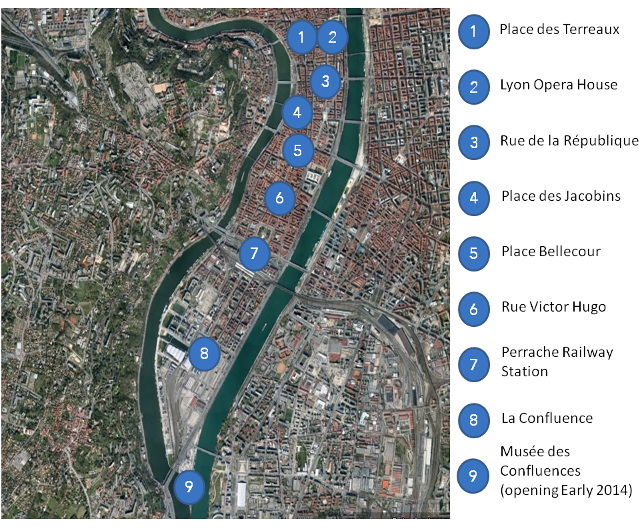
The river Saône starts in north-eastern France, in a little village called Vioménil. Its name comes from the Celtic river goddess Souconna. For 480 kilometres, it runs south, flowing through or close to some major towns in eastern France, such as Dijon. Lyon is the meeting point of the Saône and the Rhône, an 812 kilometre long river that starts in the Valais Swiss canton. Flowing through the countryside and Lake Geneva, it reaches Lyon and then flows south to the Mediterranean Sea, via Vienne, Avignon and Arles.
Between the Saône and the Rhône, the Presqu’île is situated along 5 kilometres, from the “Place des Terreaux” to “la Confluence”, where the two rivers meet.
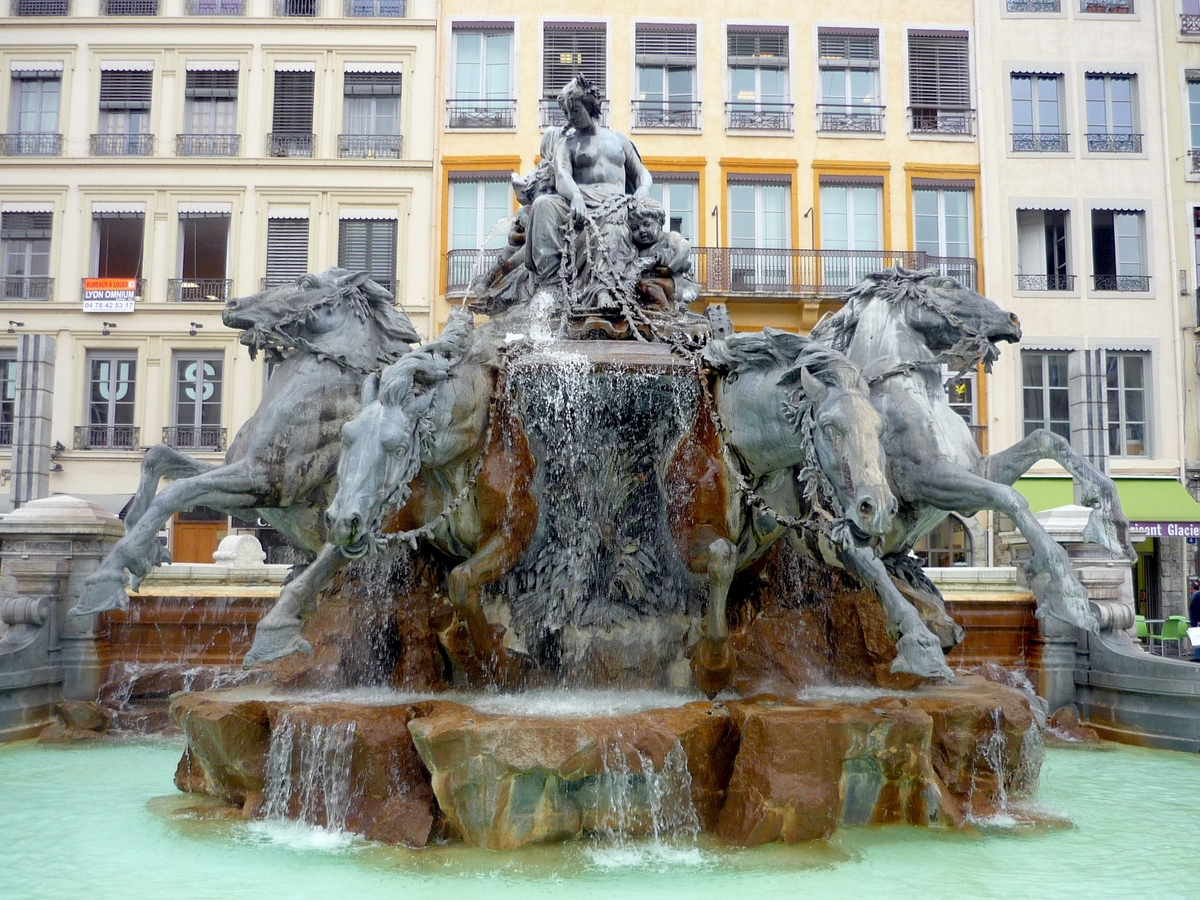
Before the Romans set up in this area, the Presqu’île was mainly under water. There were only a few islands, appearing and disappearing according to various levels of rainfall.
Place des Terreaux et Hôtel de Ville – Terreaux Square and Town Hall
When the Romans founded Lugdunum, the Saône met the Rhône in this area. During the Renaissance, loam (terreau) was used to fill in the former Rhône’s riverbed which no longer flowed there.
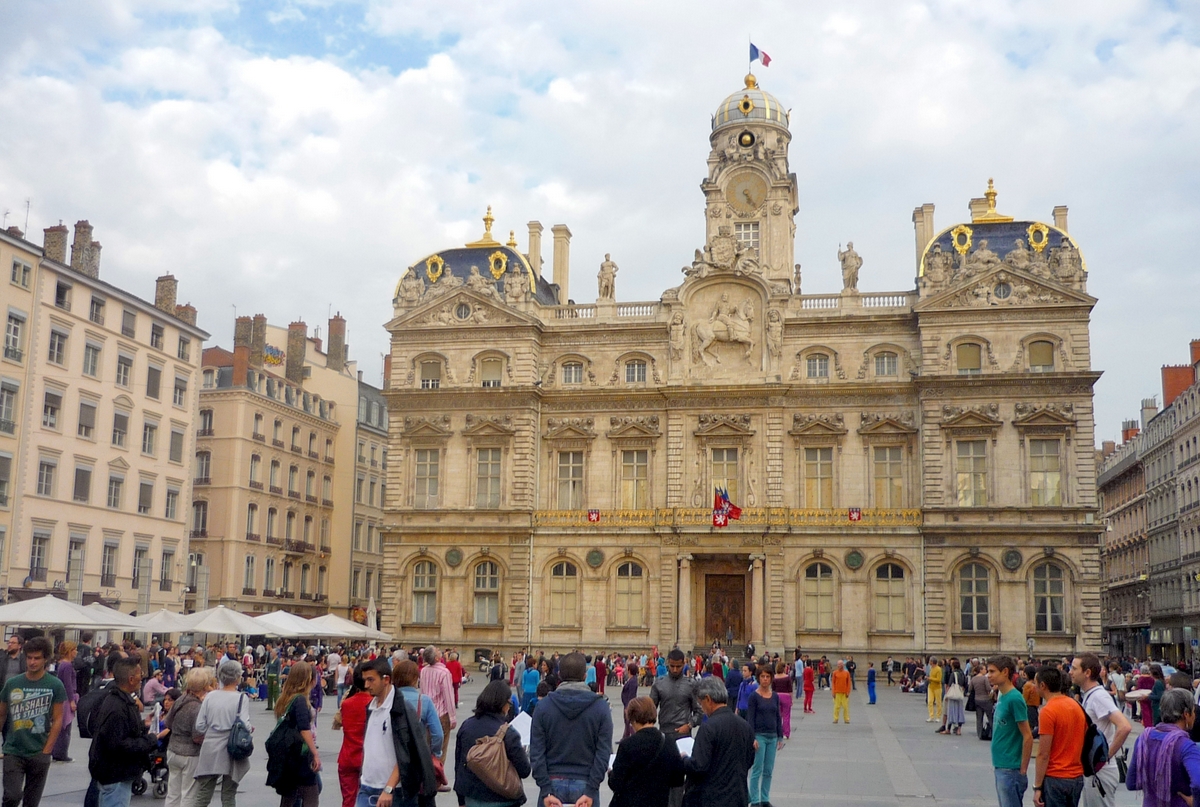
Nowadays, Terreaux Square is one of Lyon’s must-see places. This 7,000 m² area is very beautiful and well maintained. There, you can see a gigantic fountain made by Bartholdi in 1894. This famous French sculptor also created the Statue of Liberty. A hundred years later, the square was totally renovated by architect Christian Drevet and sculptor Daniel Buren. It is now paved with granite, and fourteen pillars along with sixty-nine water-jets decorate the square.
“Place des Terreaux” is also known as “Place de l’Hôtel de Ville” (Town Hall Square), since the Town Hall has been situated there since the 17th century.
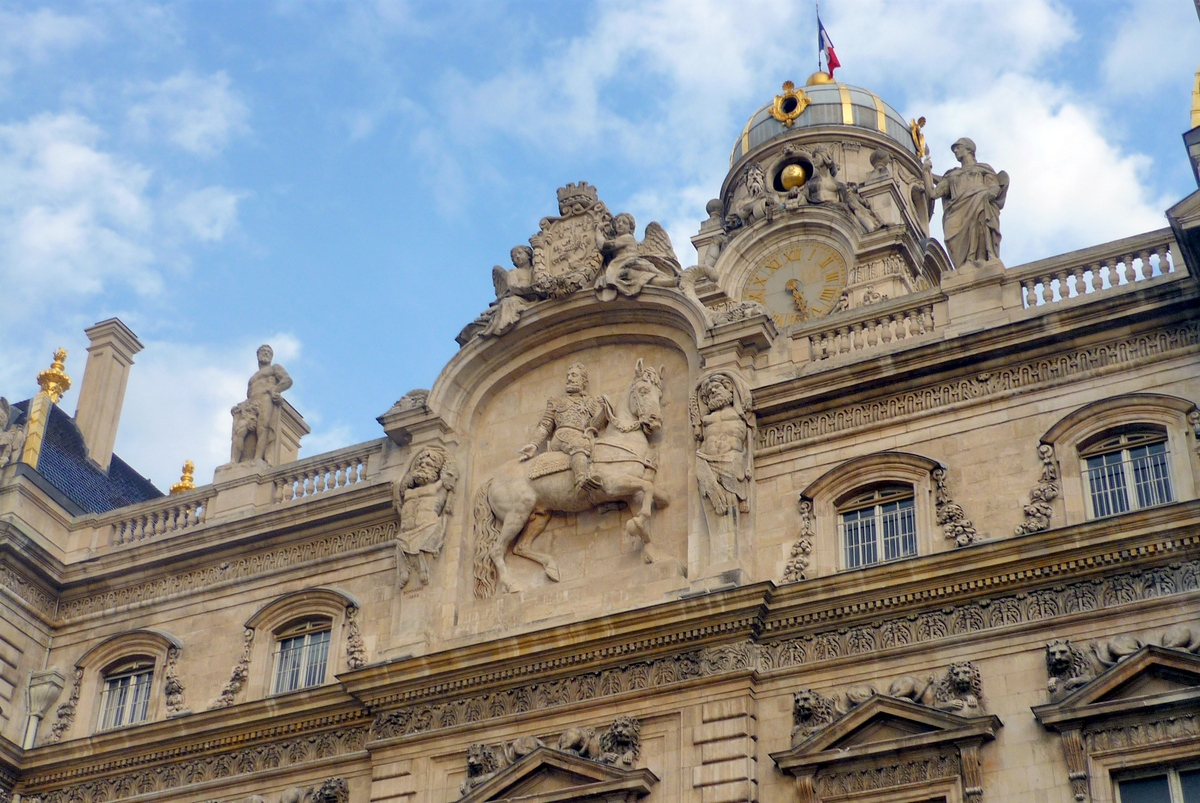
Two years after being built by Simon Maupin, it was partly destroyed by fire in 1674. The front of the building was redesigned by Jules Hardouin-Mansart, who changed it significantly. Nowadays, Lyon Town Hall is one of the most emblematic monuments in the town. It has an oblong shape framing the main courtyard. This superb part of the Hall hosted a dinner for the G7 summit in 1996. Inside, there are many paintings, frescos and decorated ceilings. In the “Salle de la Nomination” (Proposition room), the ceiling is decorated with a painting called “The glory of Louis XIV”, who was King of France when the Town Hall was built.
At Southern Terreaux Square, there is the “Palais Saint-Pierre” (Saint-Peter’s Palace). Originally, it was used as a Benedictine abbey for women called “Les Dames de Saint-Pierre” (Saint-Peter’s ladies).
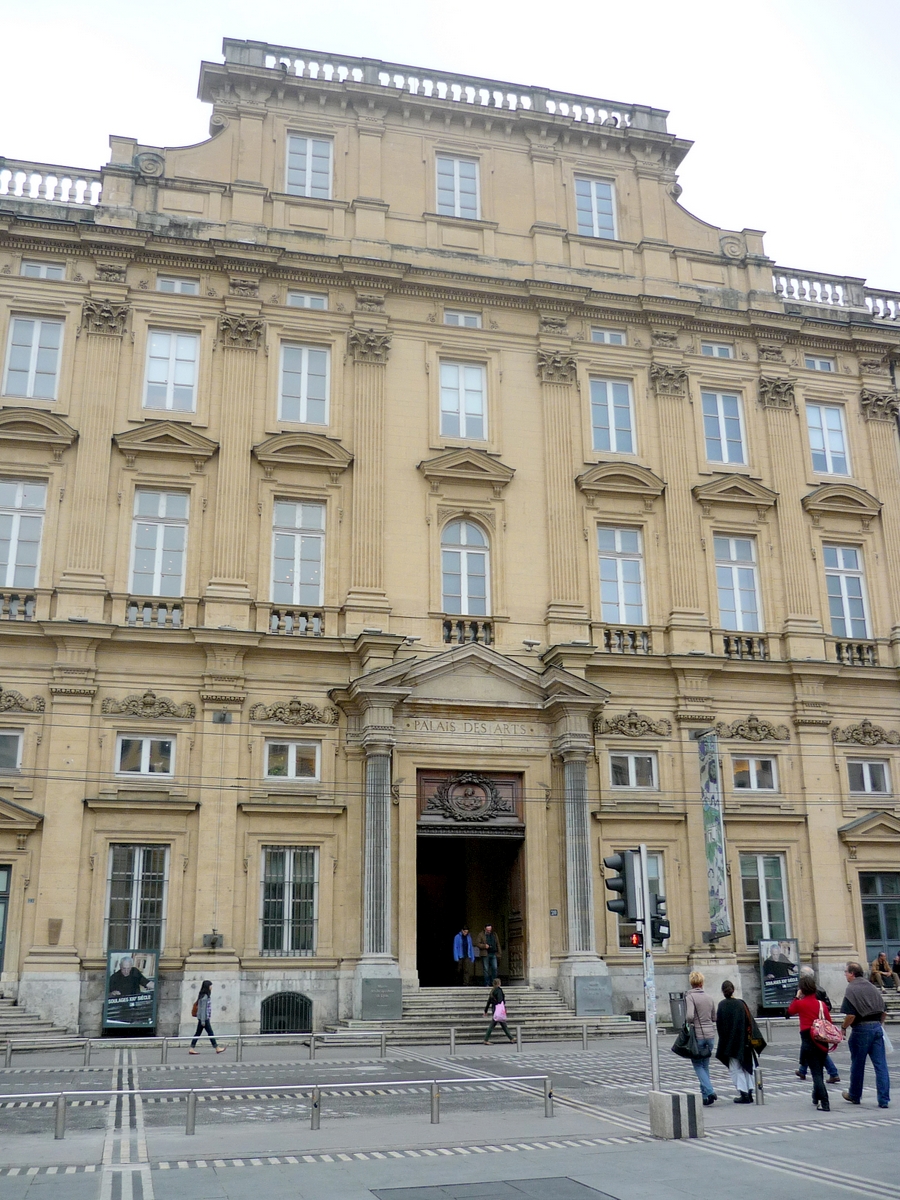
During the French Revolution, while Terror was prevailing, the nuns left the convent. In 1803, Napoleon decided to turn it into a museum. Since then, the “Musée Saint-Pierre” (Saint-Peter’s Museum) has been generally considered the most impressive of Lyon’s museums. The main courtyard of the Palace is a peaceful garden, where you can have a rest far from the city’s bustle. The magnificent Palace rooms house paintings and sculptures dating from the 15th century to modern times. Many famous French and European artists are represented: Veronese, El Greco, David, Delacroix, Renoir, Gauguin… A specific section is dedicated to ancient Egyptian, Greek and Roman art.
L’Opéra de Lyon – Lyon Opera House
Behind Terreaux Square and Lyon Town Hall stands another square, called “Place Louis Pradel” (Louis Pradel Square). The idea of building this square first arose in the early 1970s as a means to create entrances for the new Lyon underground. Lyon’s mayor at the time, Louis Pradel, did not want to ruin Terreaux Square with such entrances. The mayor died a few months before the square was completed. Consequently, it was decided to call the new square “Louis Pradel”, as a tribute to its creator.
Louis Pradel Square is actually a path between Lyon Town Hall and Lyon Opera House. In the 18th century, a theatre was built there by famous French architect Jacques-Germain Soufflot. However, only sixty years after its construction, it was considered dilapidated and was demolished. From 1829 to 1831, a new opera house was built, designed by Antoine-Marie Chenavard and Jean-Marie Pollet. Constructed as a square with columns all around, the building was inspired by the architecture of the ancient Greek and Roman Empires. However, the final result did not reflect the original plans. For example, only 1,800 people could be seated in the opera house. According to the original design there should have been up to 2,420. The mayor decided to ask another architect, called Dardel, to complete the job.
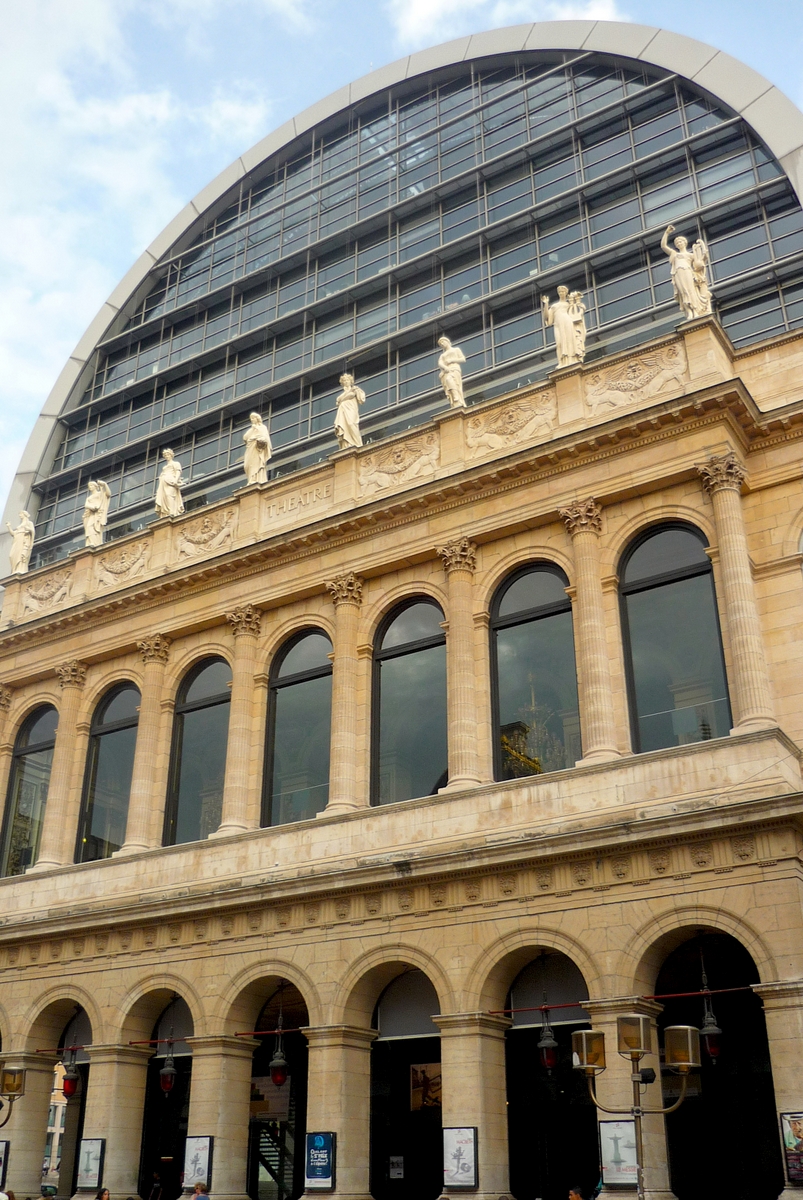
In 1986, a competition was launched by Lyon’s then Mayor Francisque Collomb in order to find the best architect to renovate the opera house. Famous French architect Jean Nouvel won the contest. Nouvel only kept the outside and the foyer of the former building. The whole inner part of the opera house was changed. Nowadays, the classical structure of the theatre meets with modern architecture, giving the building a very special atmosphere. The biggest change can be seen from the outside. Nouvel added an enormous glass dome at the top of Lyon’s opera house, which is quite unique!
From Terreaux Square to Cordeliers area
Only three hundred metres from Terreaux Square stands « l’Eglise Saint-Nizier » (St-Nizier Church). Nizier was Bishop of Lyon in the sixth century. He is reputed to have been cured of a tumour in his youth after seeing an apparition of St-Martin-de-Tours. After that experience, Nizier decided to become a priest although he kept working as a craftsperson in order to be able to help poor people. He gave his name to a few villages around Lyon, such as Saint-Nizier-d’Azergues (Rhône department), Saint-Nizier-sous-Charlieu (Loire department) and Saint-Nizier-Le-Désert (Ain department). After his death, his body was buried in Lyon’s oldest cemetery. This place was originally dedicated to Lyon’s Christian martyrs from the first and second centuries. In the fifteenth century, a church was built there, called Saint-Nizier, as a tribute to the former bishop.
Listed as a historical monument in 1840, the entrance to Saint-Nizier Church is located on Rue de Brest (Brest Street). The building comprises gothic-style architecture.
The crypt of Saint-Nizier church, extended in the nineteenth century, is one of Lyon’s holy places. In the church itself, you can find many sculptures and paintings from the fifteenth to the nineteenth centuries. The architecture is impressive, since the church had to be partly rebuilt on several occasions. Saint-Nizier Church has suffered many riots (especially during French Revolution) and fires throughout the years. In the south chapel, Antoine Coysevox’s “Virgin and Child”, from the eighteenth century, is worth a visit.
At the south-eastern corner of Saint-Nizier Church, you can visit the “Musée de l’Imprimerie” (Printing Museum). It has been operating since 1964 and was formerly a private mansion built in the fifteenth century, called “Hôtel de la Couronne” (Crown Hotel). It then belonged to a merchant from Lyon who traded with Italian cities. The museum possesses an impressive collection of printing machinery where you can see texts from the fifteenth century, when the technique was first developed. The courtyard of the building is really beautiful and typical of the Renaissance era.
A few metres from the Printing Museum, between Place de la Bourse (Stock Exchange Square) and Place des Cordeliers (Cordeliers Square), stands the Palais de la Bourse (Stock Exchange Palace), also known as the Palais du Commerce (Trading Palace). This massive neoclassical building was inaugurated by Emperor Napoleon III and his wife, Empress Eugénie, in 1860. It originally housed the Lyon Stock Exchange, which was at its most successful in the 1920s, before the financial crisis. The Commercial Court, the Industrial Tribunal and French bank Crédit Lyonnais were also formerly housed in the building. Nowadays, the Palais de la Bourse is owned by the Chamber of Commerce and Industry of Lyon. The building is also famous in Lyon for tragic reasons. On 24 June 1894, French President Sadi Carnot was shot by an Italian anarchist while leaving the Palace. A memorial stone is set in the exact place where the President was standing at the moment he was shot.
From Cordeliers Square to Bellecour
To reach Place Bellecour from Place des Terreaux, you can walk through two main streets. The biggest one is Rue de la République (Republic Street). It is the main commercial street of Lyon where there are many shops, cafés and restaurants. For instance, the Printemps is located on Place de la République (Republic Square), next to Rue de la République. Around Christmas time, the street is especially attractive, with many lights everywhere. The street is paved and you can only get there on foot or by bike. So if you want to do shopping while enjoying one of the most emblematic streets of Lyon, you know where to go now!
To the west of Rue de la République, there is a similar street called Rue du Président Edouard Herriot (President Edouard Herriot Street). Edouard Herriot (1872-1957) was a French Council President. He was Lyon’s Mayor from 1905 to 1954, with only a five year break during World War II. Unlike Rue de la République, this street is not closed to traffic. At the southern end of the street, there are many luxury shops.
Next to Place de la République to the west of Rue du Président Edouard Herriot’s there is a pretty square called Place des Jacobins (Jacobins square). It is surrounded by many classical and impressive buildings. At the centre of the square is a magnificent fountain which was built in 1886. The fountain itself was built by Gaspard André, whereas the four statues on each side of it were sculpted by Charles Degeorge. The sculptures are tributes to four great artists from Lyon: architect Philibert Delorme, painter Hippolyte Flandin, sculptor Guillaume Coustou and etcher Gérard Audran.
To the west of Place des Jacobins, the rue Mercière (Merchant Street) runs from north to south. It is worth a look because it is one of Lyon’s oldest streets, thought to have been built at the end of the third century.
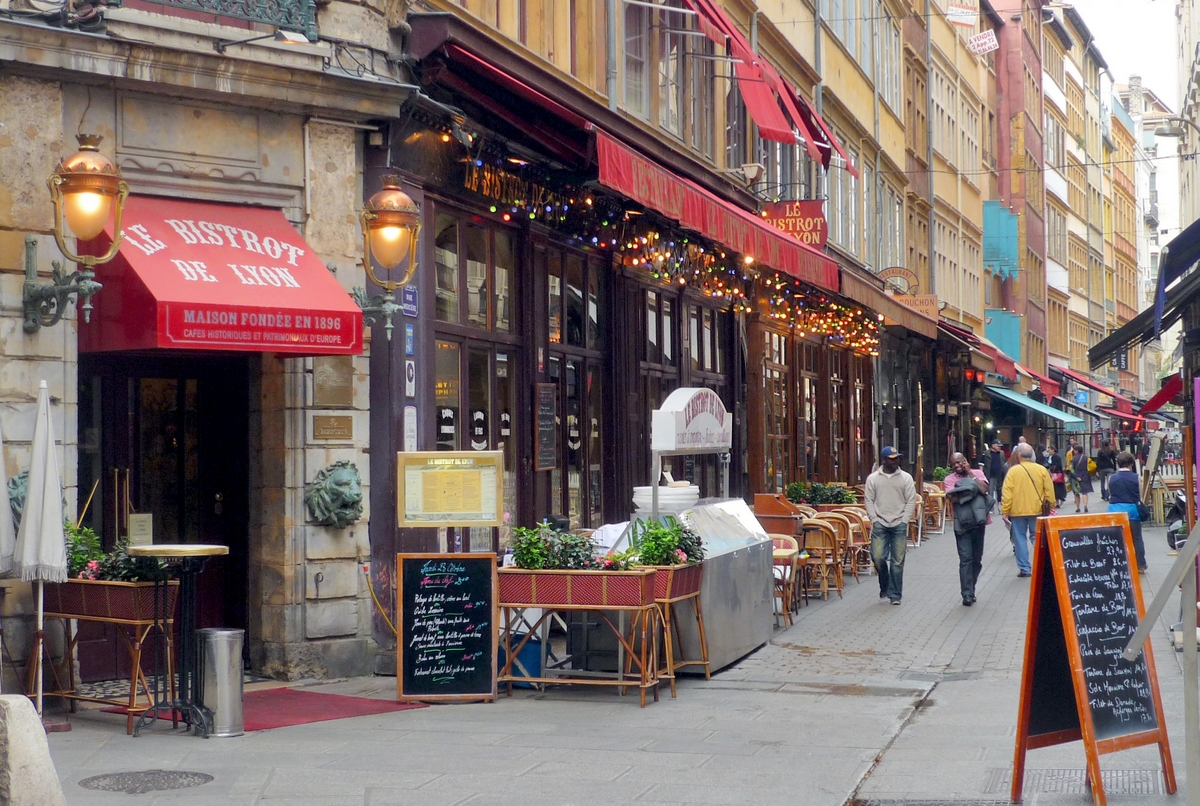
It is now closed to traffic however rue Mercière was one of Lyon’s main streets until the eighteenth century. It knew many centuries of intense economic activity: many printing factories were located there and the first book ever printed in French was produced on this street (at number 56)! The street became less vibrant at the end of the nineteenth century. In 1958 it was renovated and has become since then one of Lyon’s most iconic streets and a great place to go out in the evening. There are many restaurants and cafés where traditional cuisine from Lyon can be discovered.
If you walk down Rue de la République, almost to Place Bellecour and turn to the east, you will reach the banks of the Rhône. There you will see a massive building: “l’Hôtel-Dieu”.
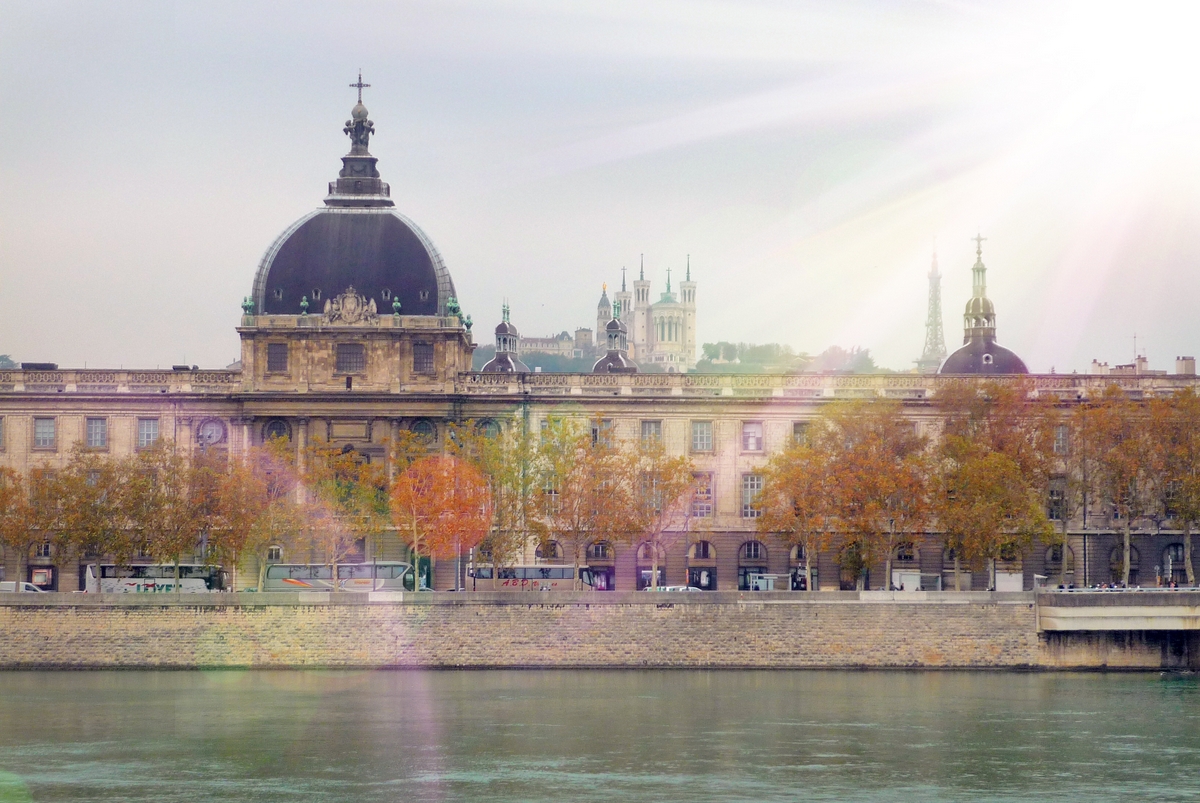
It was built in its current form in the eighteenth century. The Hôtel-Dieu was one of the most effective medical research centres in the twentieth century. It was a teaching hospital and a museum until 2011. Since then, the building has been closed for refurbishment. By 2015, it will house a luxury hotel and a shopping arcade. Architects have made a commitment to respect the historical legacy of the building. For example, the courtyard will remain public and accessible to everyone.
Place Bellecour
Place Bellecour (Bellecour Square) is one of the most famous sites in Lyon. Being 500 metres long and between 220 and 280 metres wide, it is the biggest pedestrian square in Europe. As the “centre of the centre” of the city, it is a meeting place for many people. Many events take place there, especially at weekends, most of them organised by foundations.
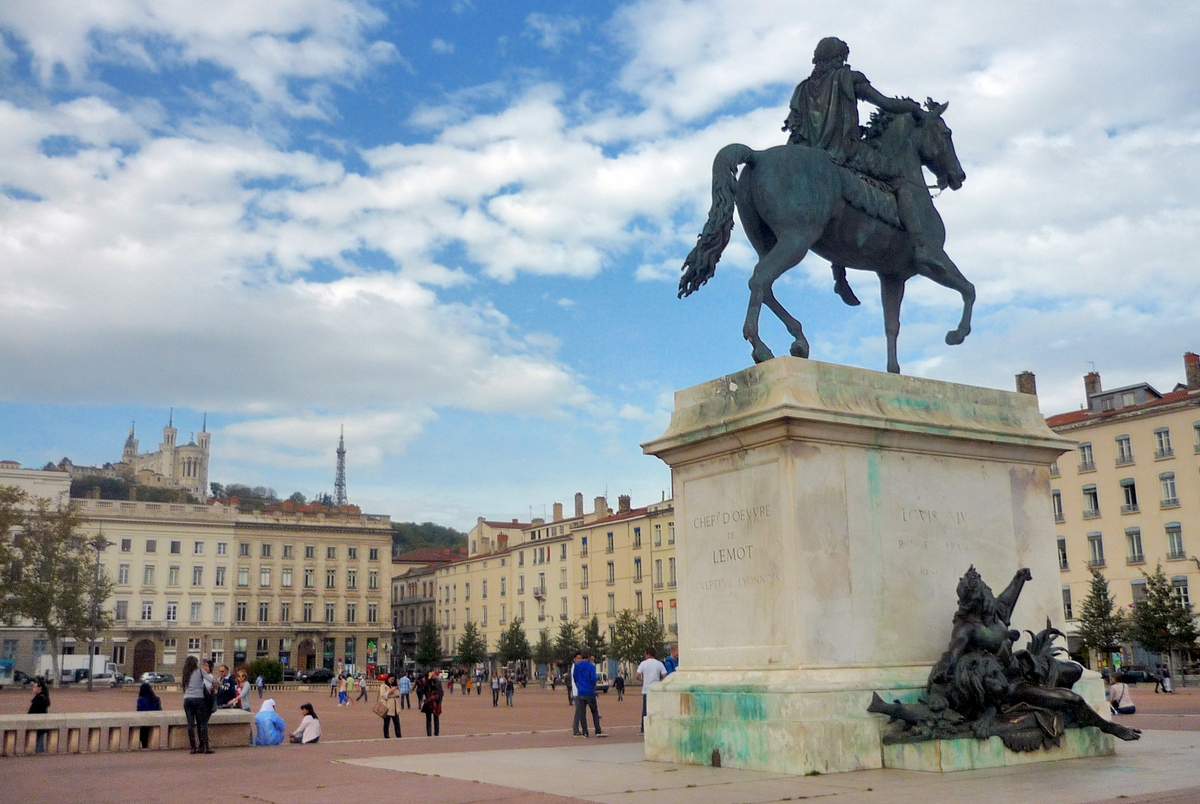
Bellecour’s site was a rubbish dump in the Middle Ages. For centuries, the church and the royal government fought over the site. Finally, in 1708, Louis XIV took control of the site permanently. In 1713, a statue honouring the “Roi Soleil” by Martin Desjardins was erected there. After being knocked down during the French Revolution, it was rebuilt in 1828 by François-Frédéric Lemot. The square has been known as Place Bellecour since the last third of the nineteenth century, after being called different names for almost two hundred years, mainly for political reasons, as is the case with many streets and squares in Lyon and other French cities. It used to be called, for example, “Place Royale” (Royal square), “Place de l’Egalité” (Equality square) and “Place Napoléon” (Napoleon square).
If you stand in the centre of the square, you can see Fourvière Hill including the Basilica. But let’s continue our journey through the Presqu’île!
Southern Presqu’île: from Place Bellecour to Perrache
When you leave Place Bellecour to the South you will come across Rue Victor Hugo (Victor Hugo street). This commercial street joins the famous square to Perrache railway station. The street was built in the early 19th century. When the subway was opened in 1974, Rue Victor Hugo was closed to traffic, becoming the second longest pedestrian way in Lyon after the Rue de la République.
When reaching the little square called Place Ampère (Ampère square), you can go to the west and find the Basilique Saint-Martin d’Ainay (Saint-Martin d’Ainay Basilica). This former abbey was built in the 12th century. As with many religious buildings in the town, it suffered damage during the French Revolution. Nowadays, it remains one of the only Romanesque churches in Lyon. Inside the church, you will find many paintings, especially frescoes, honouring Lyon’s martyrs such as Saints Blandine and Pothin.
At the south end of Rue Victor-Hugo, Place Carnot (Carnot Square) is worth a visit. It can be surprising sight with many old trees surrounding it. Built in the second half of the 18th century, the square was first called “Place des Victoires” (Victories square), to celebrate the power of the French empire in Europe. As with most of Lyon’s squares, the Place Carnot has had several names over the past two centuries, following the turbulent changes in France’s history: “Place Louis XVI”, “Place Louis XVIII”, “Place de la Liberté”, “Place de la République”, “Place Napoléon” and “Place Perrache”. Contrary to popular belief, the square did not take its name from President Sadi Carnot, who was shot in Lyon in 1894. Actually, it was named “Place Carnot” in 1889, in order to pay tribute to General Lazare Carnot, Sadi Carnot’s grandfather.
Don’t be surprised when reaching Place Carnot: at the northern end of the square, cars must drive… on the left, like in England and Australia! In the centre stands the Statue de la République (Statue of the Republic) which represents the French revolution. The square is also famous for hosting Lyon’s Christmas markets. Every December since 1996, 140 traders (from 700 applicants) are carefully selected by Lyon’s council, based on the type of products they sell and of course their quality! Even if not as big as the north-eastern Christmas markets (such as Strasbourg, Colmar and Metz), Lyon’s Christmas markets have become an important meeting place in the Rhône-Alpes region during the December celebrations, along with the Festival of Lights.
La Gare de Perrache – Perrache railway station
If you are standing at Place Carnot, you cannot miss seeing the impressive building and the tunnels located at the southern end of the square. This is where Gare de Perrache (Perrache railway station) is located. The station, designed by architect François-Alexis Cendrier, was opened in 1857. Antoine-Michel Perrache, the town planner who created the district where the railway station stands, gave the station its name.
Perrache station was originally a hub for regional journeys. Until the 1930s, from Perrache, you could only travel to cities in what is now called “Rhône-Alpes”, such as Saint-Etienne, Valence and Grenoble. Then, in 1938, the Paris-Grenoble line, crossing Dijon and Lyon, was opened. Perrache station constituted the main railway hub of Lyon’s agglomeration and of the Rhône-Alpes region until the early 1980s. In 1981, the TGV (Train à Grande Vitesse, the fastest train in France) started to run from Paris to Lyon. Perrache station was the end stop for every train coming to Lyon until thirty years ago. However, it has now become a less important hub in Lyon, while the newly built Part-Dieu station has grown in importance thanks to its location in a large planned business district outside of the central city and its connection to the TGV lines.
Perrache station was totally rebuilt in the 1970s, while Lyon’s subway network was being built. It has now become an important hub for the public transport system of the town. Nowadays, Perrache is the final stop of subway line A and of tramway line T2. The T1 tram joins the north-east of Lyon to Confluence (Presqu’île south), crossing Part-Dieu and Perrache stations. Many buses start and end their journey in Perrache bus station.
A new district called “La Confluence”
Because of the location of Perrache railway station, the Presqu’île was physically divided into two distinct parts for years. With the buildings, the tunnels and all the railway platforms, the station has been nicknamed “Le plat de nouilles” (the noodles dish)…
In the 1990s, Lyon’s municipal authorities became concerned that the south of the Presqu’île, where the Saône and the Rhône meet, had been neglected for many years. For example, there was almost no public transport south of Perrache station! Raymond Barre (1995-2001) and Gérard Collomb (since 2001) have been the two Lyon mayors who have pondered on this district’s future.
The first goal was to link the south of Presqu’île to the whole town. It was decided to extend the T1 tramway from Perrache to the Confluence district. In 2014, it will be extended again, joining the Gerland district in Lyon’s south-east. Some bus lines have also been established to join Perrache and Northern Lyon.
The second aim of the project was to make Confluence a housing, business and commercial centre. A modern semi-open commercial centre was built in 2011, and many companies chose to install themselves in this area, such as Lyon’s offices of GDF-Suez and most of the town’s advertising agencies. Also, many apartments were built, adhering to new environmental standards. Indeed, the third objective of the Confluence project was to create a district at the cutting edge of technology and having regard to environmental considerations. All the buildings have been constructed following strict specifications.
Finally, the fourth and last target was to create a new cultural area in Lyon. “La Sucrière”, a former sugar warehouse, was redeveloped and became Lyon’s contemporary arts centre. In 2014, the “Musée des Confluences” (Confluence museum) will be unveiled. Being the biggest of Lyon’s museums, it will be very attractive for the people of Lyon and for tourists thanks to the variety of its natural history collections, its location (right at the meeting point of the Rhône and the Saône) and its architecture. The very modern building, made of concrete and glass, was nicknamed “the spaceship” when it was previewed in the early 2000s. It can be seen when you are driving on the A7 motorway, which joins Lyon to southern France.
To get more information about Lyon Presqu’île and its buildings, you can visit the Tourist Board of Lyon.




